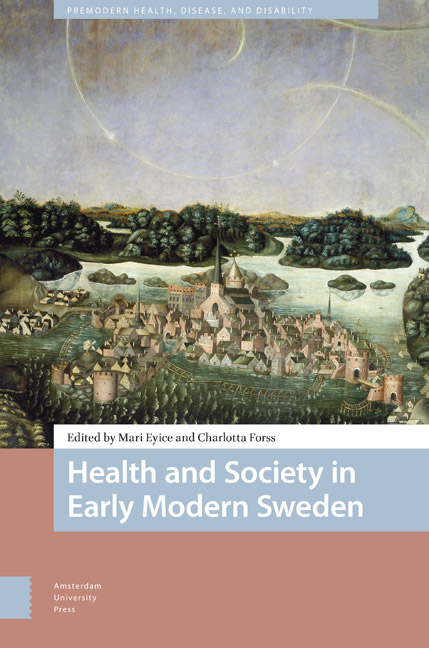Book contents
- Frontmatter
- Contents
- List of Tables and Figures
- Acknowledgements
- 1 Meanings of Health in Early Modern Sweden
- 2 Illness as Incapacity to Work in Early Modern Sweden
- 3 The Body in the Bathhouse: Health and Bathing in Early Modern Sweden
- 4 ‘Somewhat Heated, Quick and Lively’ : Humoral Explanations of the Learning Difficulties of Charles XI of Sweden (1655–1697)
- 5 Health in Body and Soul in a Female Birgittine Convent 1516–1522
- 6 Curing Madness and Mental Disturbances : Religious Healing Activities in Early Modern Swedish Local Communities
- 7 Not Quacks but Close : Reappraising the Role of Physicians on the Eighteenth-Century Medical Market
- 8 Gender, Health, and Hair in Sweden, 1740–1840
- 9 Gender Norms and Early Modern Healthcare : Barber-Surgeons in Sweden c. 1600–1900
- Epilogue : Epistemologies of Body and Soul: Considering the Early Modern and (Late) Modern History of Health
- Index
3 - The Body in the Bathhouse: Health and Bathing in Early Modern Sweden
Published online by Cambridge University Press: 16 April 2024
- Frontmatter
- Contents
- List of Tables and Figures
- Acknowledgements
- 1 Meanings of Health in Early Modern Sweden
- 2 Illness as Incapacity to Work in Early Modern Sweden
- 3 The Body in the Bathhouse: Health and Bathing in Early Modern Sweden
- 4 ‘Somewhat Heated, Quick and Lively’ : Humoral Explanations of the Learning Difficulties of Charles XI of Sweden (1655–1697)
- 5 Health in Body and Soul in a Female Birgittine Convent 1516–1522
- 6 Curing Madness and Mental Disturbances : Religious Healing Activities in Early Modern Swedish Local Communities
- 7 Not Quacks but Close : Reappraising the Role of Physicians on the Eighteenth-Century Medical Market
- 8 Gender, Health, and Hair in Sweden, 1740–1840
- 9 Gender Norms and Early Modern Healthcare : Barber-Surgeons in Sweden c. 1600–1900
- Epilogue : Epistemologies of Body and Soul: Considering the Early Modern and (Late) Modern History of Health
- Index
Summary
Abstract
This study examines what was considered healthy and unhealthy in relation to the early modern Swedish sweat bath culture. Health in the bathhouse, or sauna, was far from straight forward. Instead, an array of factors was understood to work together to determine if a particular bath was healthy for a particular body, at a particular time. By mapping out these complexities, the study brings attention to how different interpretative frameworks and practical circumstance interlinked in the day-to-day determination of what was healthy in the early modern period. While health was a signifier of the good life, it was also understood as situation-dependent, tied to body types and to places.
Keywords: balneology, sauna, bathhouse, history of the body, health, social practice
Introduction
Walking through the streets of early modern Stockholm, a visitor would, sooner rather than later, encounter the sign of a public bathhouse. A set of metal dishes or a bunch of birch tree twigs hung outside a building was a sign that one could take a sweat bath, or sauna, within. Some sweat baths were large establishments, run by the masters of the city's Bathing Guild. Others were more transitory, illicitly set up and catering to community needs for bathing and socialising. In early modern Sweden (including Finland), there were sweat baths in the cities, in smaller towns and in the countryside. These were places where people met to talk and have a good time. Indeed, nineteenth- and twentieth-century historians and folklorists viewed the sweat bath as an integral part of Nordic medieval and early modern culture. In recent years, however, the bathhouse culture of early modern Sweden has largely been overlooked by historians. This chapter makes a case for reinstating the bathhouse as an integral part of early modern Swedish culture. In particular, in early modern Sweden, a visit to the bathhouse was understood to affect a person's health.
The introduction to this volume contends that ‘health’ as a concept in early modern Sweden referred both to bodily and mental well-being, and to a broader understanding of a person's prosperity in life. Health was also used as a metaphor in religious, moral, and political conceptions of society.
- Type
- Chapter
- Information
- Health and Society in Early Modern Sweden , pp. 57 - 82Publisher: Amsterdam University PressPrint publication year: 2024



